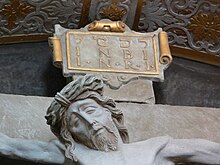Quod scripsi, scripsi

Quod scripsi, scripsi (Latin for "What I have written, I have written") is a Latin phrase. It was most famously used by Pontius Pilate in the Bible in response to the Jewish priests who objected to his writing "King of the Jews" on the sign (titulus) that was hung above Jesus at his Crucifixion. It is mostly found in the Latin Vulgate Bible.[1] It is equivalent to the Latin expression Dixi (Latin for "I have said"), meaning that the speaker has spoken and there is no more to be said.

History
The phrase appears in the Bible in John 19:20–22. When Jesus was sent to be crucified, Pilate wrote the sign to be hung above Jesus on the cross. He wrote "Jesus the Nazarene, King of the Jews" in Hebrew (or, more correctly, Aramaic.[2]) Latin and Ancient Greek. The Jewish priests voiced their objections of this to Pilate, stating that Jesus had only claimed the title and they did not recognise Him as such. They said to Pilate, "Do not write King of the Jews, but that he said: 'I am the King of the Jews'."[3] Pilate responded to them sternly with "Quod scripsi, scripsi" (Greek: Ὃ γέγραφα γέγραφα, Ho gegrapha gegrapha). This was interpreted by Jerome as an allusion to the headings of Psalm 56 and Psalm 57, which in the Vulgate seem to refer to an inscription that is not to be changed.[3][4]
The scene where Pilate says "Quod scripsi, scripsi" was not covered in art or discussion as a popular subject. Aside of the
Other uses
In 1306, when
On being released from imprisonment in 1418, Antipope John XXIII came, broken down and destitute, to Florence, and was given an asylum there by Giovanni di Bicci de' Medici, who, when the deposed Pope died in the following year, erected to his memory the tomb which is to be seen in the Florence Baptistery. When the inscription was put up (after Giovanni's death), Pope Martin V objected to the words "Quandam Papa" (former Pope) and wrote to the Signoria demanding that they should be erased. The reply was a refusal, written by Cosimo de' Medici, and couched in the words of Pontius Pilate, saying, "Quod scripsi, scripsi."[6]
The philosopher Immanuel Kant used a play on "Quod scripsi, scripsi" in response to critics of his Metaphysics of Morals, using "Quod scripsi, scribentes" (What I have written, I am writing).[7]
References
- ^ "The Cloisters Cross". Metropolitan Museum of Art – The Cloisters. Retrieved 2014-03-18.
- ISBN 0-06-065580-1, p. 2051
- ^ ISBN 0-8146-1283-0.
- ^ a b Longland, Sabrina. "Pilate answered 'What I have written, I have written'" (PDF). Metropolitan Museum of Art. Retrieved 2014-03-18.
- ISBN 978-1108020633.
- )
- ISBN 978-1-4411-9674-3.
